12 Shade Perennials that Will Beautify Sheltered Areas of Your Yard
Is there anything lovelier than a shade garden on a warm day? It’s hard to beat!
If you’ve cared for flowers before, you likely know that not all flowers can tolerate full sun, especially during summer.
When exposed to high temperatures and direct sunlight, many of them will quickly burn and shrivel.
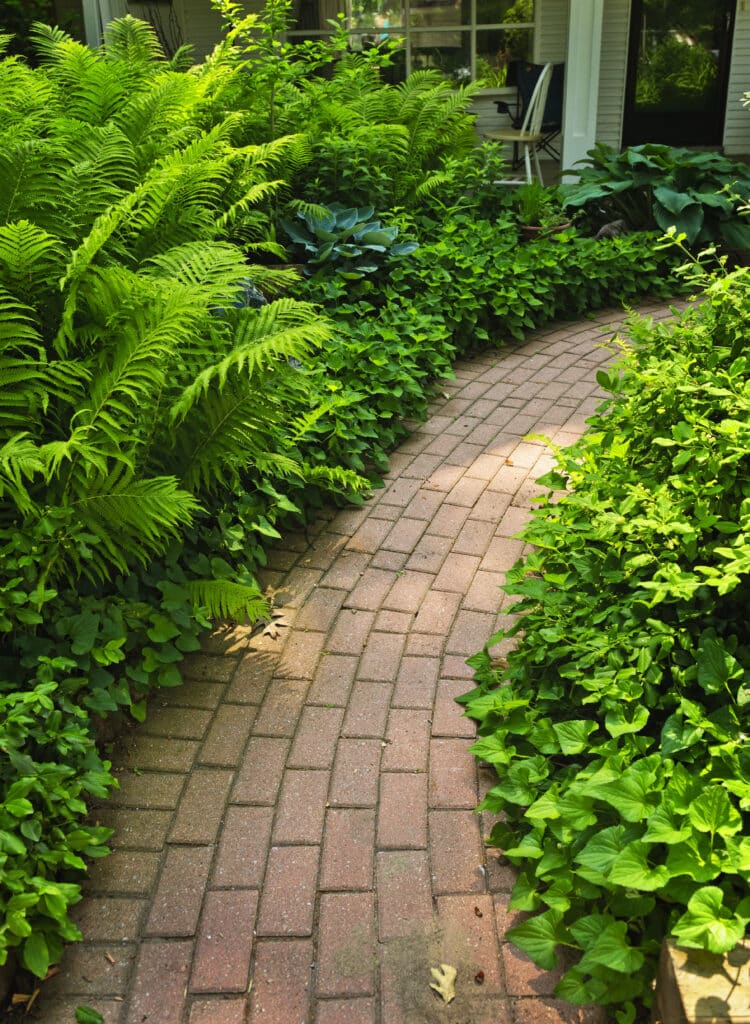
On the other hand, some plants require plenty of sunlight to grow and bloom properly.
This is why it’s important to know your plants’ sunlight requirements before making any purchases; you want to ensure you have the right environment to help them reach their full potential.
If you have shaded areas of your yard you’d like to fill with beautiful plants, shade perennials are an excellent option!
This content may contain affiliate links. If you shop via the links, I receive a small commission at no cost to you. Thank you for supporting my small business.
Why You’ll Love Shade Perennials
- They add interest to your landscaping
- Low maintenance once they’re established
- There’s plenty of variety in size, color, and texture
- They’ll come back year after year, unlike annual flowers
- Use them in a cutting garden to bring flowers indoors
- Attract pollinators and hummingbirds
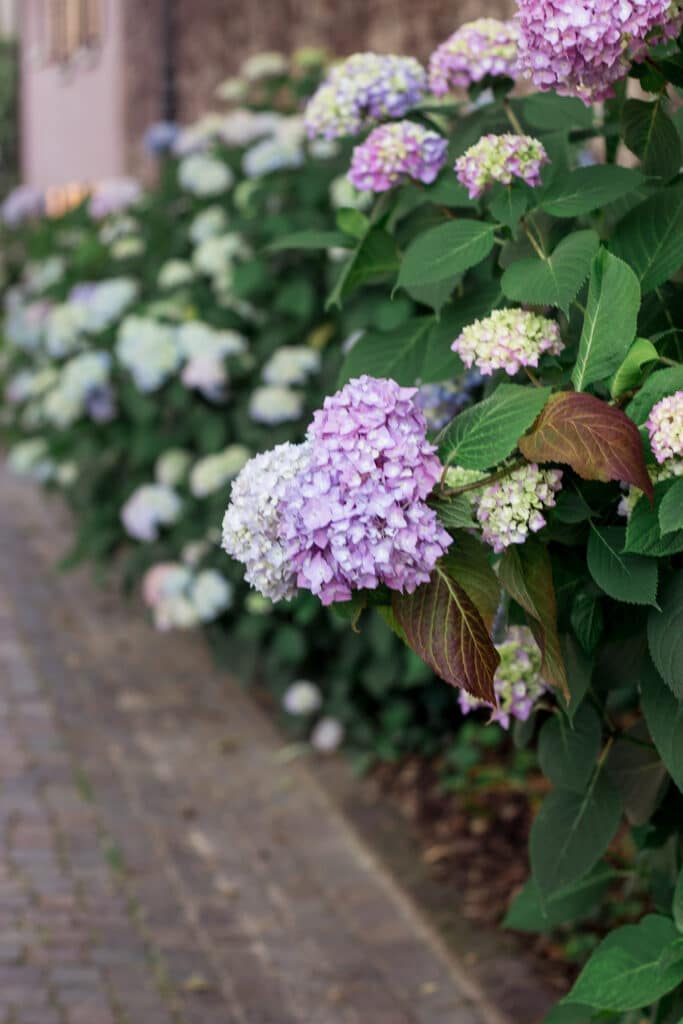
12 Shade Perennials for Your Garden
1. Hosta
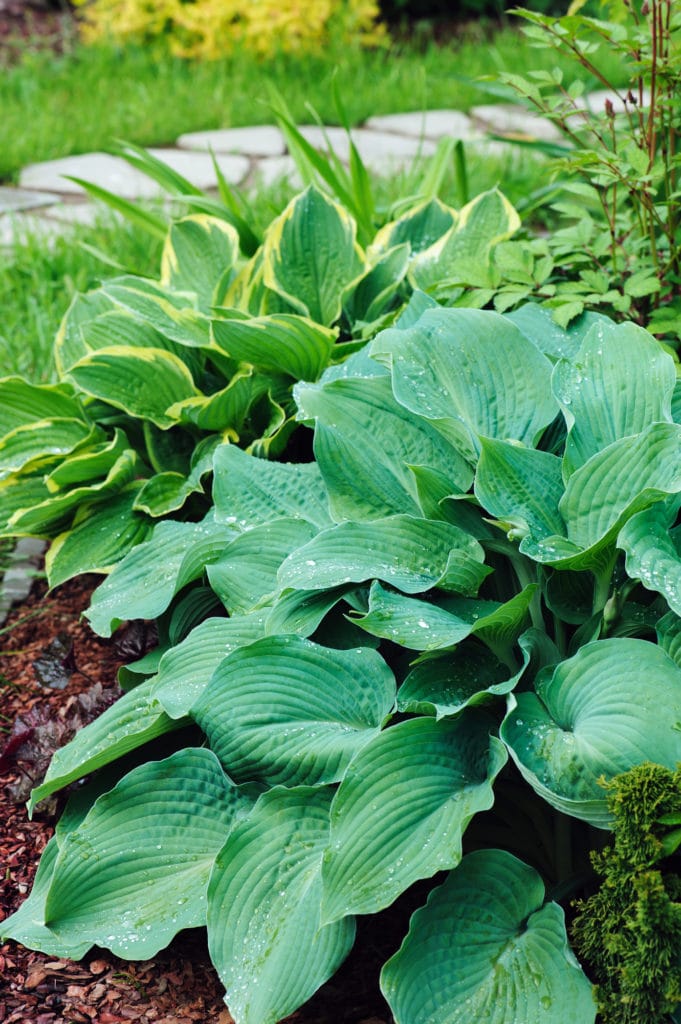
You can’t create a list of shade perennials without mentioning hosta. It’s the workhorse of so many gardens worldwide and one of the most popular plants.
Hosta is an excellent choice for shade gardens because:
- it’s low-maintenance
- it’s versatile: use it in garden borders, as ground clover, in containers, and in any sheltered area of your yard that needs to be filled
- it complements delicate and colorful flowers with its rich green foliage
Hostas are susceptible to snails and slugs, though. They love to feed on its leaves! It can be a nuisance, so you must be diligent and apply a natural insecticide.
Hardiness zones: 3-8
Sunlight conditions: Best in part to full shade
Soil: Well-drained with medium moisture
(Read this post for quick and inexpensive DIY garden pest solutions).
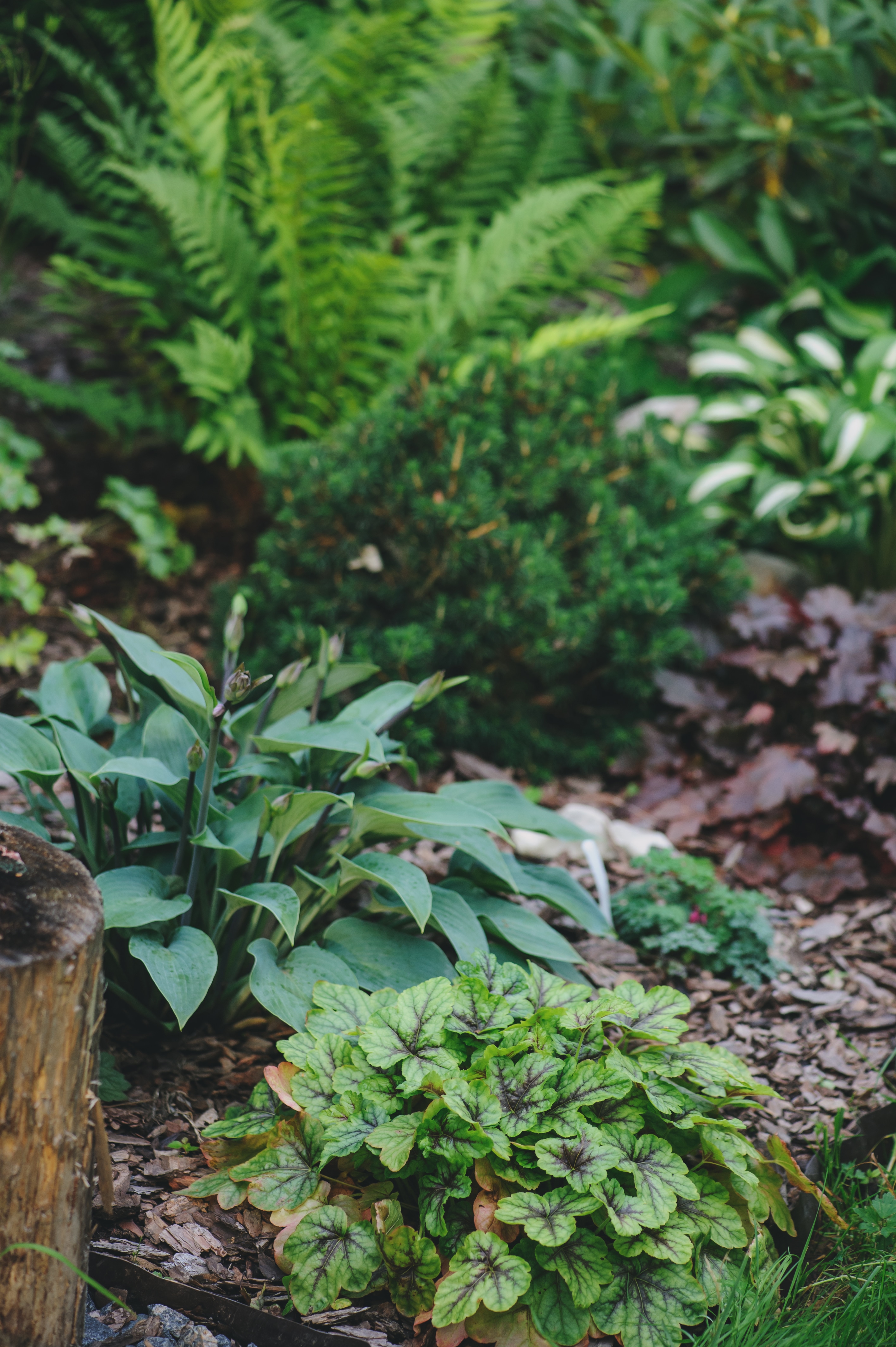
2. Astilbes
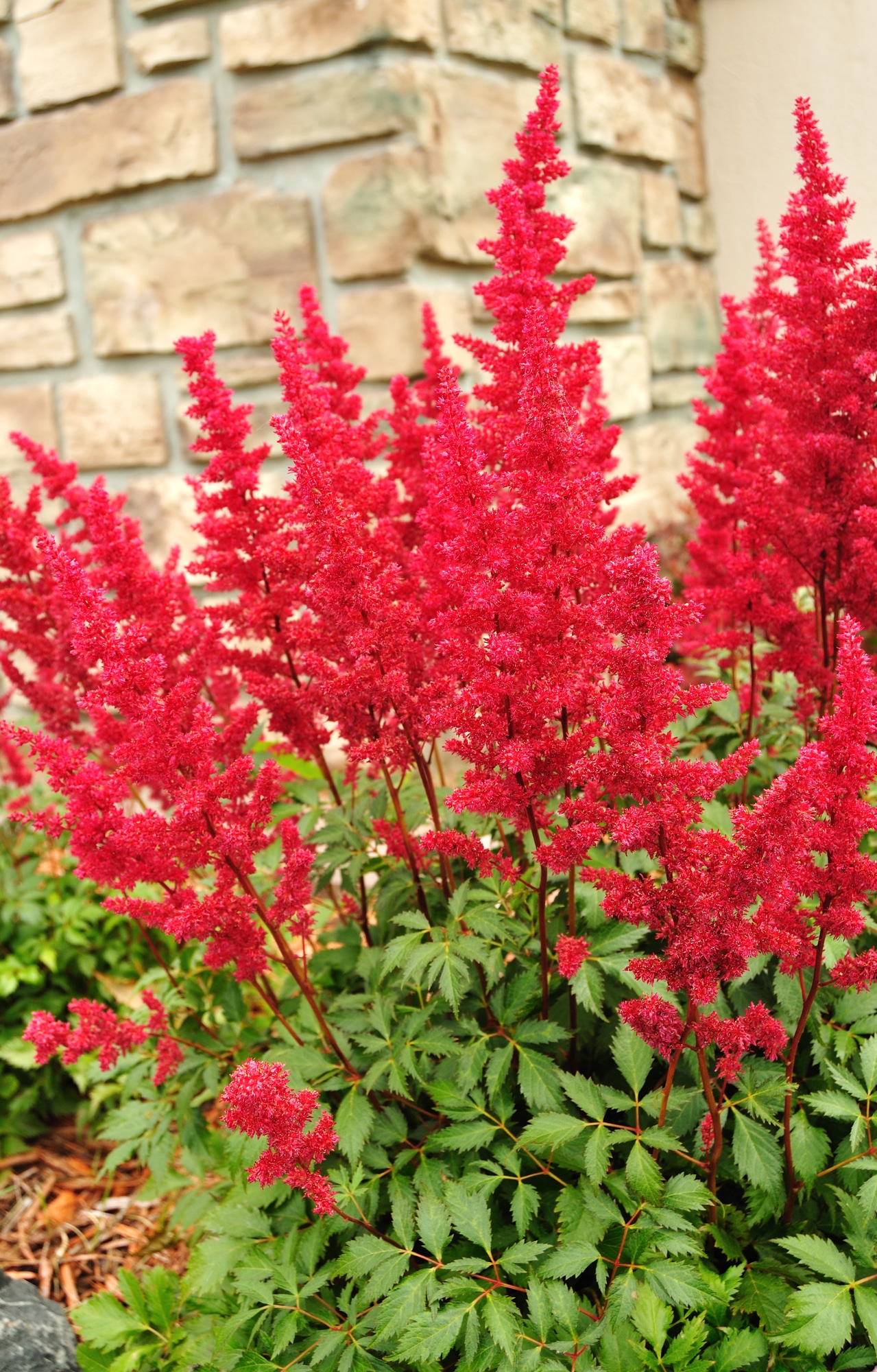
The astilbe flower is another popular choice for shade gardens.
The plant is beloved for its tall, fern-like, feathery flower clusters that grow upright and pop bright colors.
Astilbe flower is a great shade perennial because:
- it makes for a striking show
- it blooms before other summer perennials
- it’s easy to care for
- it’s rabbit and deer-tolerant
- it grows well next to hostas and ferns in a garden border
- it adds height and interest to the garden
Hardiness zones: 4-9
Bloom time: late spring to early summer
Sunlight conditions: Best in full shade. Can burn in direct sunlight
Soil: Rich and well-drained with medium moisture
Water: Water regularly but avoid water-logged soil. Make sure soil never dries out completely during hotter months.
To learn more about this lovely shade perennial, visit my post on How to Care for Astilbes.
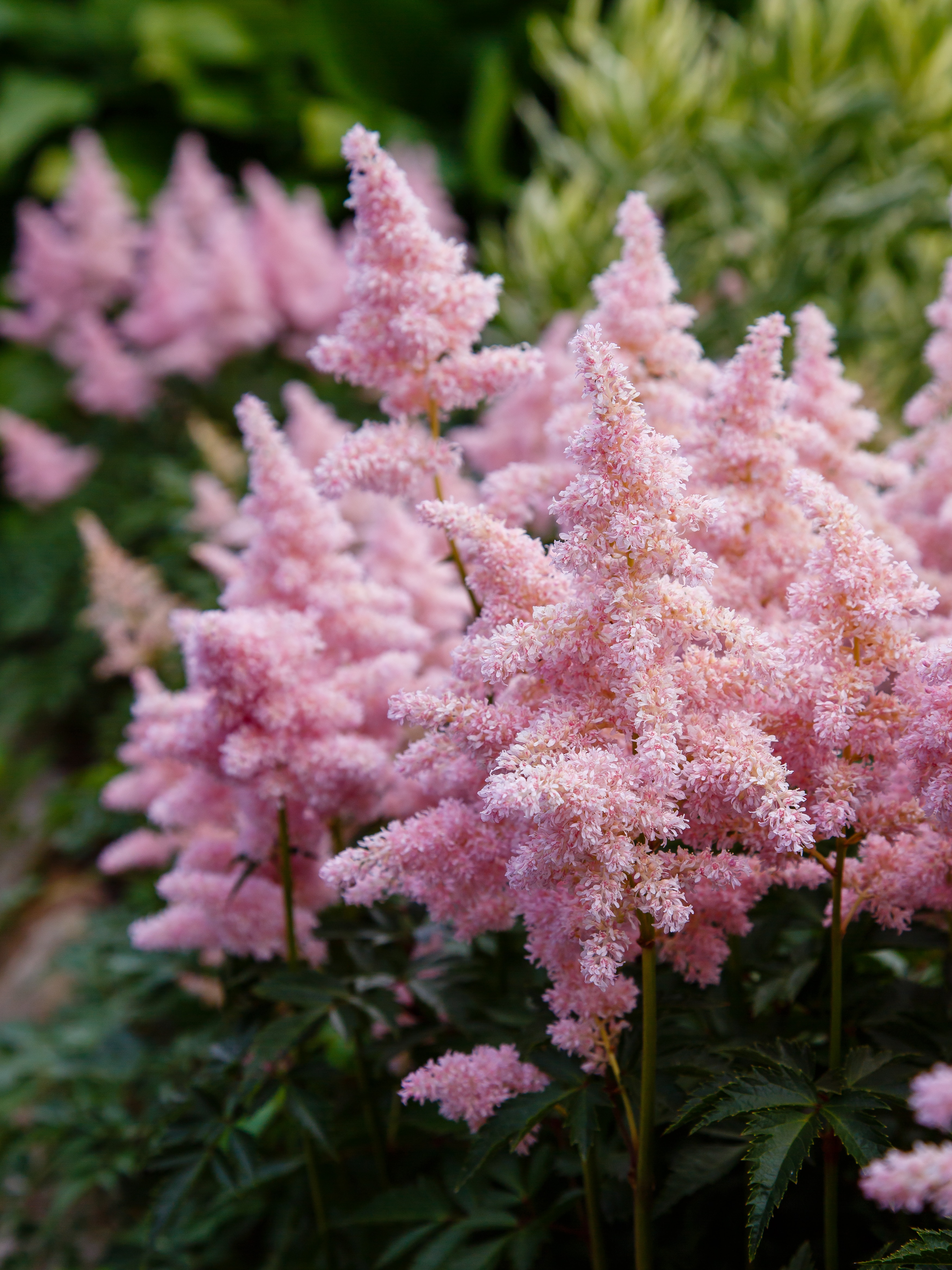
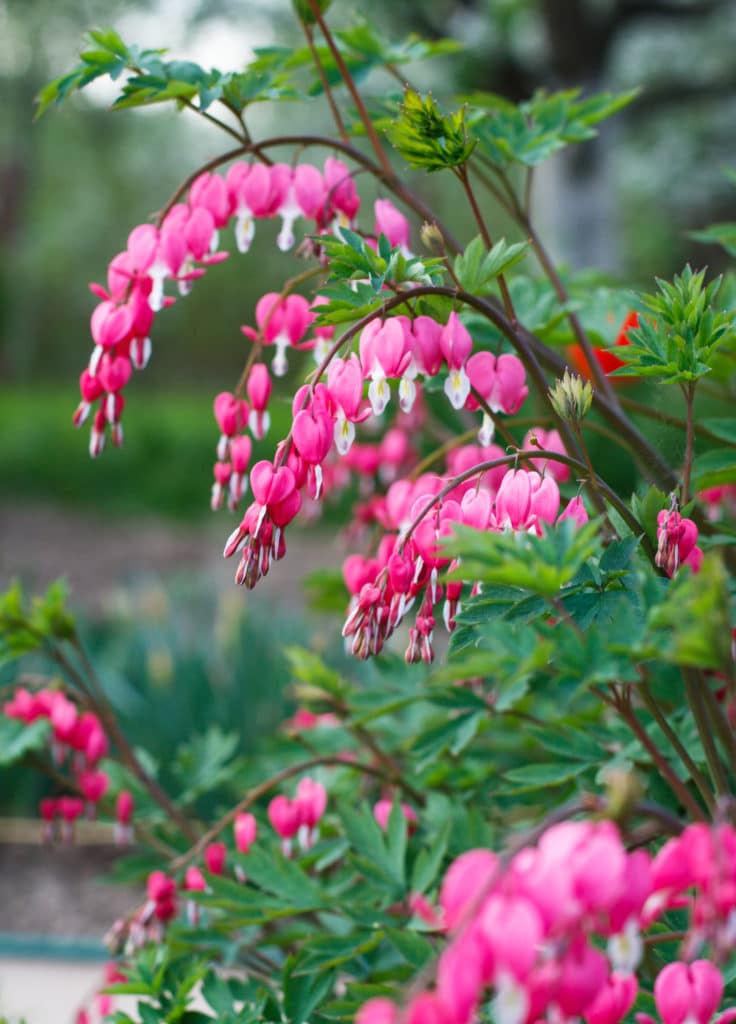
The old-fashioned bleeding heart is one of the prettiest flowers in existence. It loves to grow in shade gardens!
Reasons to love Old Fashion Bleeding Heart Plant:
-it’s low maintenance once established
-it can come back for years
-its unique, heart-shaped flowers that drop downward add intrigue to the garden
-it’s also beautiful in potted arrangements
-it pairs well with hostas and ferns
Hardiness zones: 3-9
Bloom time: late spring
Sunlight conditions: Best in full shade. Can burn in direct sunlight
Soil: Fertile and well-drained
Water: Water regularly, but avoid water-logged soil.
4. Anenome
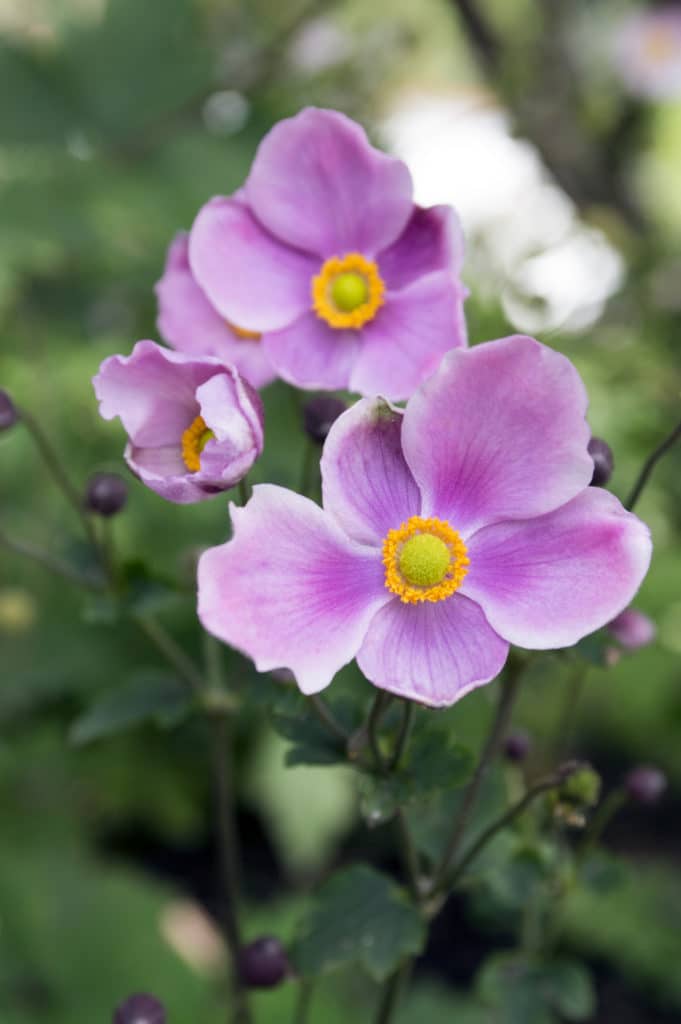
There’s nothing like watching a beautiful fall garden grow as the weather changes to cooler temperatures.
The Japanese Anenome is a perfect shade perennial because:
-it comes in a variety of colors so it adds life to a fall garden
-it pairs beautifully with other shade plants like ferns, hostas, and Fireworks Goldenrod
-it spreads quickly in moist and fertile soil
-its deer-tolerant
-can tolerate part-sun
Hardiness zones: 4-8
Bloom time: August and September
Sunlight conditions: Part to full shade. Can tolerate partial sun
Soil: Fertile and well-drained
Water: Water regularly, but avoid water-logged soil.
5. Ferns
There’s a never-ending variety of ferns, so choose a variety that appeals to you and also thrives in your zone.
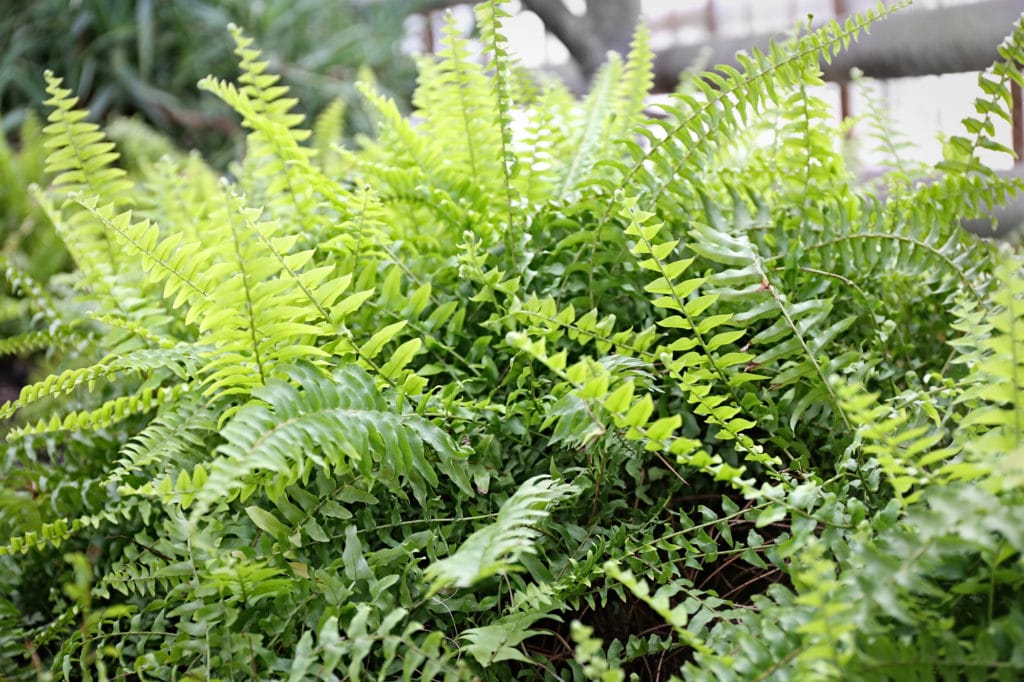
Ferns are just like hostas in that they can be the building block of a shade garden and offer tons of interest and cover large areas.
Here are a few other qualities that make ferns perfect for shade:
-their unique leaves can liven up sparse areas of your yard. Plant a few of them along a border for a beautiful walkway!
-they add a ton of texture and interest to plain landscapes
-they can thrive in full shade
-propagate them and use them as indoor plants!
Hardiness zones: 3-9
Bloom time: August and September
Sunlight conditions: Part to full shade
Soil: Rich, acidic, and well-drained
Water: Moist but keep good drainage
6. Hydrangeas
Hydrangeas might be the most beloved shade perennial of all time!
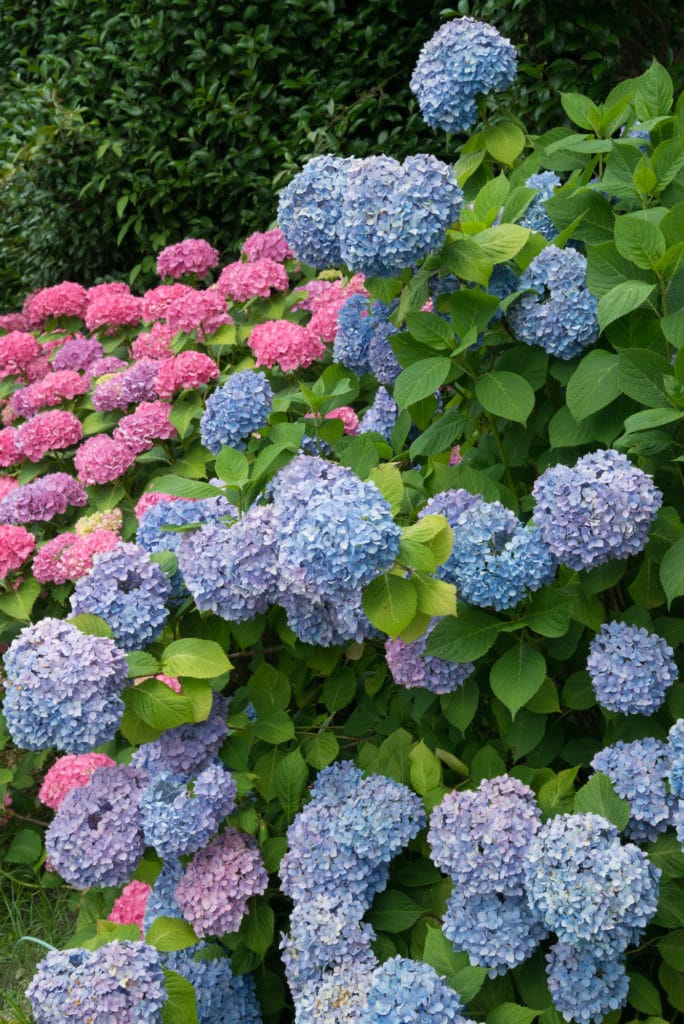
That might be a slight exaggeration, but hydrangeas, with their large clusters of beautiful flowers, can bring life and romance to front yards.
Think French-country cottage style, with hydrangea shrubs bordering the entire front of the house. Gorgeous!
Hydrangeas have a long list of characteristics that make them the perfect shade perennial:
-they’re a low-maintenance perennial that isn’t too fussy
-their color can be changed to pink or blue by adjusting the acidity of the soil
-their large green leaves are stunning, too
-their sticky pollen makes them great for allergy-prone gardeners
-they can thrive in many different types of soil
-they attract pollinators
Hardiness zones: 3-9
Bloom time: depending on zone and variety, can bloom late spring to fall
Sunlight conditions: Part to full shade, depending on variety and zone
Soil: Well-draining soil
Water: Moist with excellent drainage
There are many types of hydrangea shrubs, so do your research before choosing the ones best suited for your garden.
To learn more about growing this plant, head to my post about how to grow hydrangeas.
7. Lily of the Valley
A quick glance at a photo of a lily of the valley flower makes it clear why it’s such a beautiful flower. It’s truly stunning.
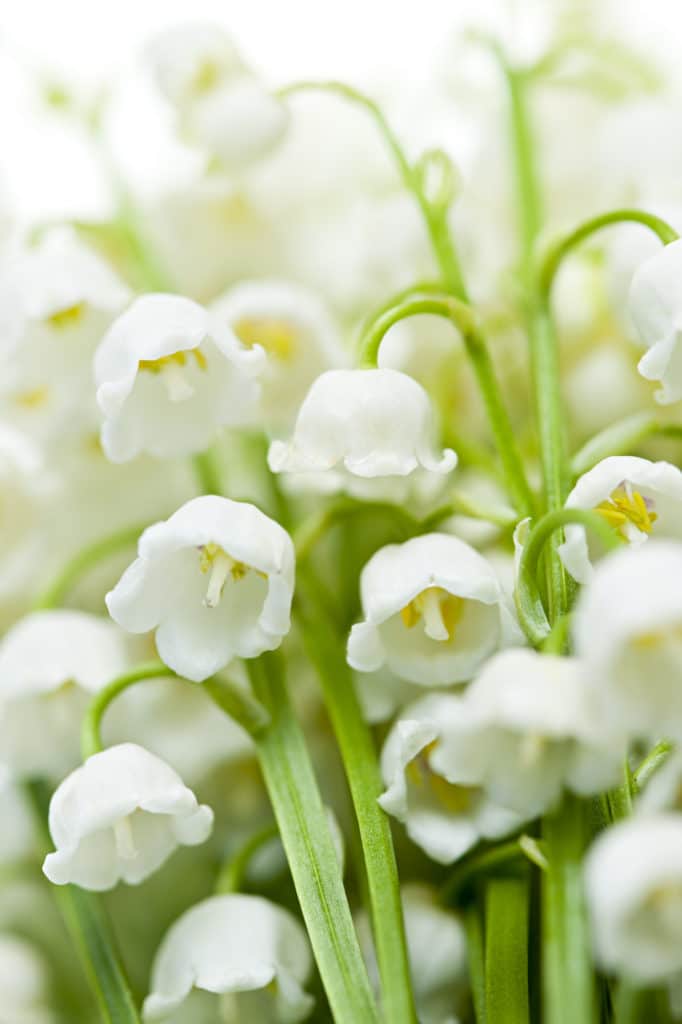
It can be quite invasive and it spreads easily, which is a common complaint among gardeners. Make sure you are okay with this plant’s growth habits before planting it. Some people say that it can be difficult to get rid of once established..
Lily of the Valley is a good shade perennial because:
-it’s so beautiful and can work well in container arrangements
-it’s fragrant
-it’s deer and rabbit-tolerant
-its white arching flower petals and green foliage make it a showy choice
-can tolerate most soils
-is very resilient
-well suited to woodland gardens
-it symbolizes joy, luck, and purity
Hardiness zones: 3-9
Bloom time: late spring to early summer
Sunlight conditions: Part to full shade
Water: Consistently moist soil with good drainage
(If you’re looking to grow a fragrant garden, don’t miss this post!)
8. Periwinkle
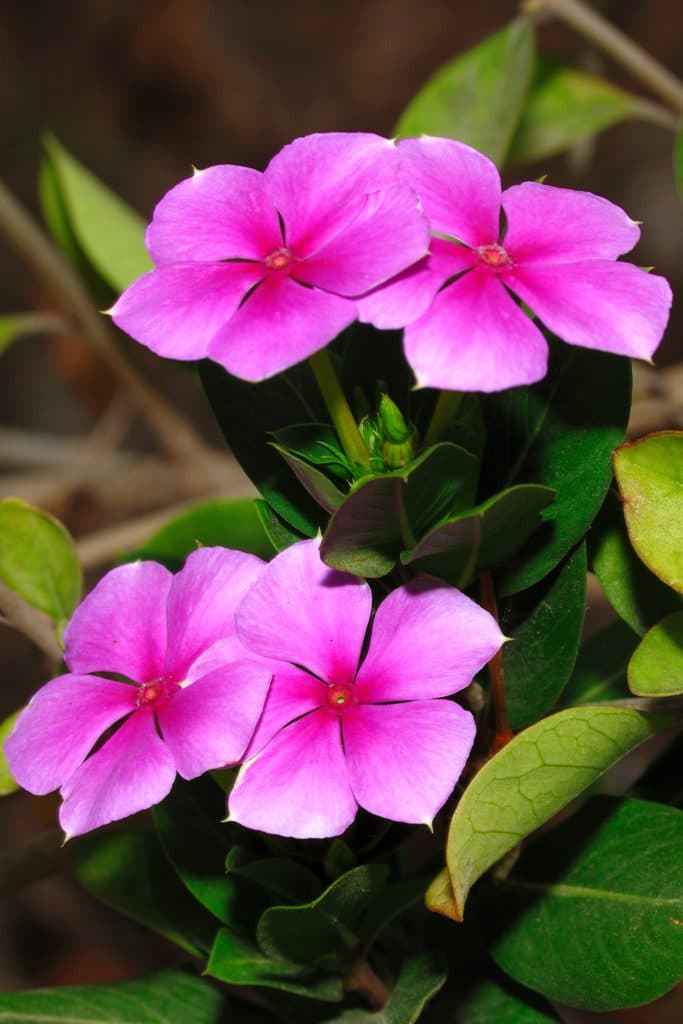
Periwinkle is a classic garden flower that every gardener should consider growing, as long as it is suitable for their hardiness zone.
They’re a simple yet perfectly lovely flower that would work well in shade containers.
Here are some positive characteristics of the periwinkle plant:
-they spread quickly, which makes them perfect as ground covers
-they’re low-growing, making them ideal as fillers in containers
-their leaves are evergreen
-can be used as a trailing groundcover plant
-can be found in shades of white, blue, purple, and pink
Hardiness zones: 4-9
Bloom time: late spring to frost
Sunlight conditions: Part to full shade. Can tolerate full sun
Soil: Prefer humusy soil that’s well-drained but it can tolerate different soils
Water: Consistently moist soil with good drainage.
9. Jacob’s Ladder
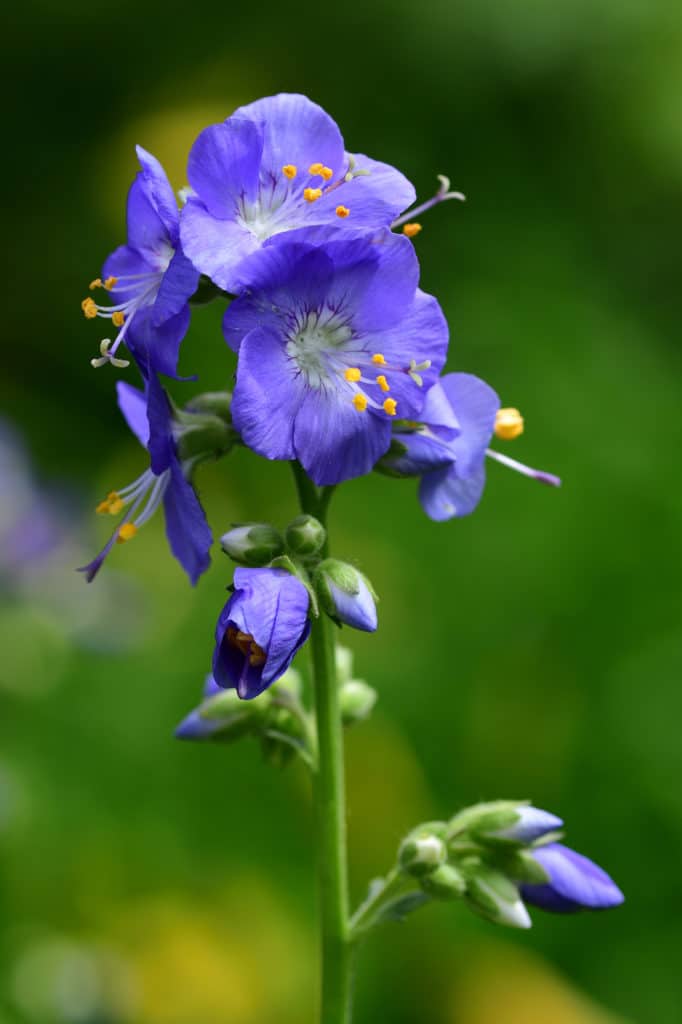
If you’re looking for a long-blooming and showy shade perennial, Jacob’s Ladder is an excellent choice!
A few things about Jacob’s Ladder:
– it brings shades of blue and purple to the garden
-it self-seeds
-it’s deer-tolerant
-it’s an early bloomer, bringing life to the garden in early spring
-its beautiful foliage stays green all summer, even after flowers are done blooming
-it attracts pollinators
Hardiness zones: 3-7
Bloom time: late spring for several weeks
Sunlight conditions: Part shade but can tolerate full sun
Water: Medium moisture
Shady areas of a yard can usually use some type of bushy foliage. If you need foliage with lots of texture, look no further than Japanese Forest Grass.
This is an especially great choice if you like adding interesting textures and leaves to your garden.
Pair it with your hostas or ferns for a stark but fitting contrast.
This shade perennial does well in zones 5 to 9 and blooms in mid-to-late Summer.
The color is more of a light green with yellow tones than a true or dark green, which actually makes it perfect for adding a layering effect to your garden.
Consider including this shade perennial to your garden plans when you do a full landscape design for your home!
11. Dwarf Crested Iris
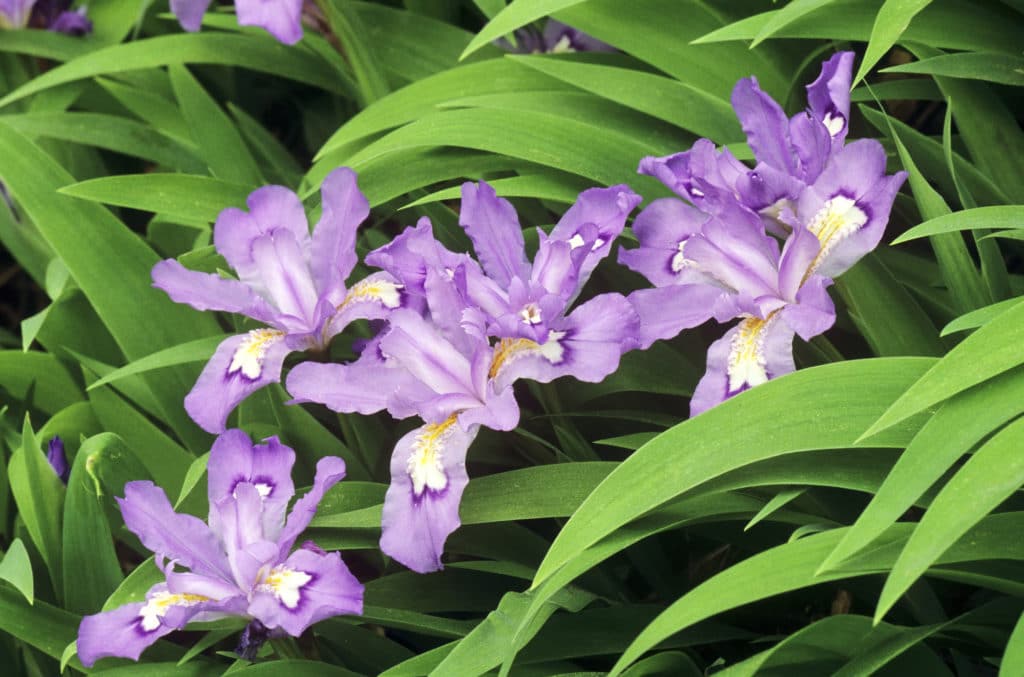
If you’re looking for a shade perennial with lilac-blue flower blooms, plant a few Dwarf Crested Irises!
It’s a unique flower that adds an interesting flair to plain gardens.
A few things about Dwarf Crested Iris:
-its easy to grow
-its foliage makes a pretty ground cover, even after flowers are done blooming
-it’s low-growing
-it’s deer-resistant
-it makes a beautiful addition to garden borders
-it’s great in rock gardens and woodland gardens
-it’s a showy flower, so plant it in the front of your garden!
Hardiness zones: 5-8
Bloom time: early to late spring
Sunlight conditions: Part shade to full shade
Water: Consistent moisture
12. Hellebore
Hellebores are some of the prettiest perennials out there, but lots of gardeners aren’t familiar with the name.
Now you are! These beauties come in different colors so choose a shade you think will go well with the rest of your garden.
Hellebores grow well in zones 3 to 9, depending on the variety.
They can tolerate drought conditions and deer but do best in rich, well-drained soil and part to full shade.
One of the best things about this shade perennial is that it has a very long blooming time: it can bloom from late Winter through the end of April!
Add this pretty flower to your low-maintenance perennial garden and you won’t be disappointed.
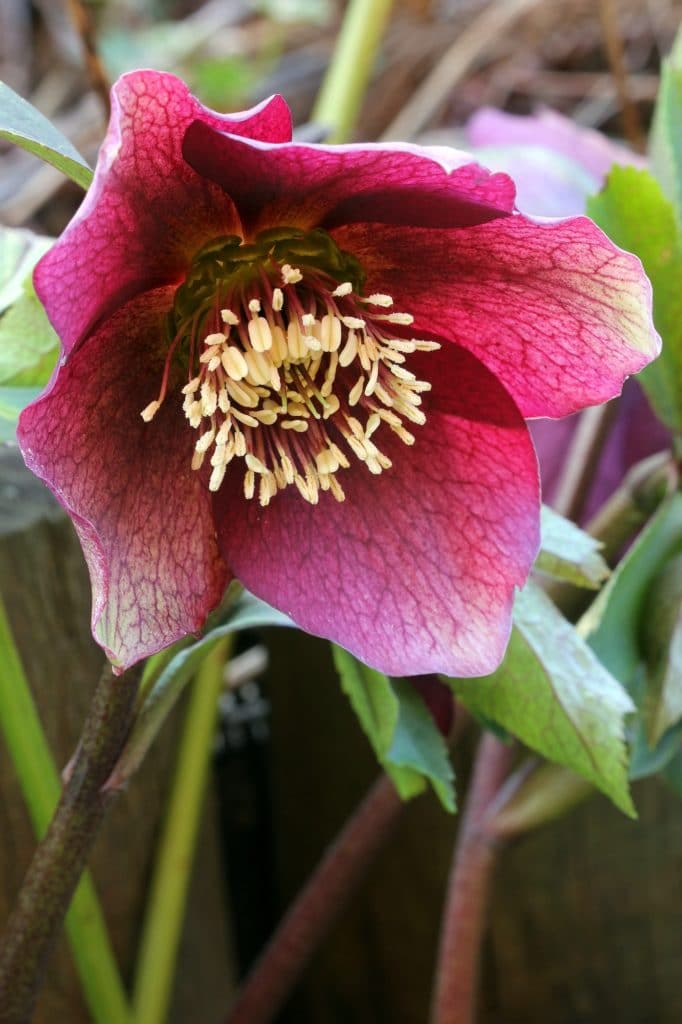
Caring for Your Shade Perennials
With proper care, your shade perennials can thrive and live for many years! Keeping plants healthy and beautiful requires adequate watering, nutrients, and maintenance.
Below are a few quick tips to help your flowers thrive:
Watering Requirements
- Consistency is key:
- Inconsistent watering can stress plants, especially during the hotter months
- Aim to keep the soil moist but not soggy and never bone dry
- Frequency:
- Weekly watering: Generally, 1 inch per week is adequate unless there’s a drought, then water every few days
- Mulching: Placing mulch on top of the soil can help retain moisture. You can apply a 2-inch layer around the base of the plant
Fertilizing for Optimal Growth
- Type of fertilizer:
- Use a balanced, slow-release fertilizer.
- An N-P-K ratio of 10-10-10 is typically recommended.
- Application timing:
- Early spring: When new growth appears.
- Midsummer: To support continued growth, if needed.
Pruning and Maintenance Tips
- Deadheading:
- Remove spent flowers to encourage new blooms. You can snip off the brown flowers where it meets the stem.
- Cleanup:
- Fall: Cut back dead foliage, sometimes all the way down to the ground. Make sure to check recommended guidelines for each plant.
- Spring: Clear any dead foliage from plant or soil
Dividing and Propagating
- Ideal timing:
- Spring or early fall: These are the best times for dividing plants. You want to avoid extreme weather.
- How to divide your shade perennials:
- Gently dig up the plant, making sure to preserve the root ball.
- Separate into smaller clumps.
- Replant separately at the same depth
Addressing Challenges in Shade Gardening
When cultivating a shade garden, you might encounter specific challenges that can impede the growth and health of your plants. Understanding these challenges is vital for a thriving garden!
Managing Pest and Disease Issues
Pest and disease problems can escalate in shaded areas due to the cooler, moist environment. Watch for common culprits such as slugs, snails, and fungal diseases to prevent infestations.
Proactive measures include:
- Regularly inspect plants for early signs of pests or diseases. Look for holes in the leaves; this is a big sign of a pest problem.
- Using organic slug bait or beer traps to control a slug problem
- Pruning plants to improve air circulation and reduce fungal infections helps a ton
- Always aim to water the soil directly, not the foliage. Overhead watering can pose a problem and lead to fungus growth and powdery mildew.
Improving Poor Lighting Conditions
Even in shaded gardens, you can optimize light exposure. Here’s how you can brighten up dim areas:
- Trim overhanging branches to allow more light into the garden.
- Install reflective surfaces, like mirrors or white-painted walls, to bounce light onto your plants.
Soil Amendment for Root Growth
Healthy soil promotes better root development, which is crucial for shade perennials. Enhance your soil quality with these steps:
- Test your soil: Knowing its pH and nutrient levels is important.
- Add organic matter: Compost can improve soil structure and nutrition.
- Mulch: A layer of mulch retains moisture and regulates soil temperature.
Incorporating Hardscape Elements
When designing your shaded garden space, combining plants like shade perennials with hardscape elements can create a captivating look. Think of hardscape as the non-living features in your yard that bring structure and year-round appeal.
- Begin with pathways: Use stepping stones or gravel to guide visitors through your garden. These paths not only help define spaces but also protect your plants from being stepped on.
- Add a focal point:
- Water Features: A small fountain or birdbath can provide a serene atmosphere.
- Statuary: Select a statue that complements the garden’s theme.
- Incorporate seating areas:
- Consider a wooden bench or stone seating to enjoy the tranquility of your garden.
- Use retaining walls or edging to:
- Separate different areas.
- Prevent soil erosion in sloped areas.
- Create raised beds for highlighting your shade perennials.
Tables or planting walls can also be attractive and functional, offering a place for potted plants or herbs.
To anchor these hardscape elements, plant your perennials around them, ensuring that they do not overwhelm your plants.
Balance is key—your hardscape should complement, not overshadow, the natural beauty of your shade perennials.
By thoughtfully integrating hardscape elements, you can achieve both aesthetics and functionality in your shaded retreat.
Remember to choose materials and designs that blend well with the natural surroundings and your style.
Seasonal Considerations for Year-Round Beauty
Your garden can maintain its allure throughout the year with the right mix of shade perennials.
By carefully selecting a variety of species that flourish in different seasons, you ensure a continuous display of foliage and flowers.
Here’s how you can plan for year-round garden interest:
Spring
Focus on early bloomers like:
- Hellebores – Enjoys cool, spring temperatures.
- Bleeding Heart (Dicentra spectabilis) – Delicate heart-shaped blooms.
Summer
Choose plants that thrive in the warmth, such as:
- Hostas – Wide variety, with lush foliage.
- Astilbe – Feathery plumes in various colors.
Fall
Many perennials peak in the autumn. Include:
- Japanese Anemones – Tall, graceful flowers.
- Ferns – Add texture as other plants fade.
Winter
Incorporate perennials with interesting foliage or bark, like:
- Bergenia – Waxy leaves often turn red or purple.
- Heuchera – Leaves in shades from green to red to black.
Timing your plantings ensures something is always growing or blooming in your shade garden.
Remember to consider the light requirements and water needs as they vary throughout the year.
With smart choices, you can enjoy a garden that’s full of life, regardless of the season!
That makes up my list of shade perennials that can easily beautify a simple garden.
Now you have a few options to consider when you begin to design your shade garden.
Remember, perennials usually come back year after year if properly care for, which means you’ll save money because you won’t have to keep purchasing new seeds or potted plants.
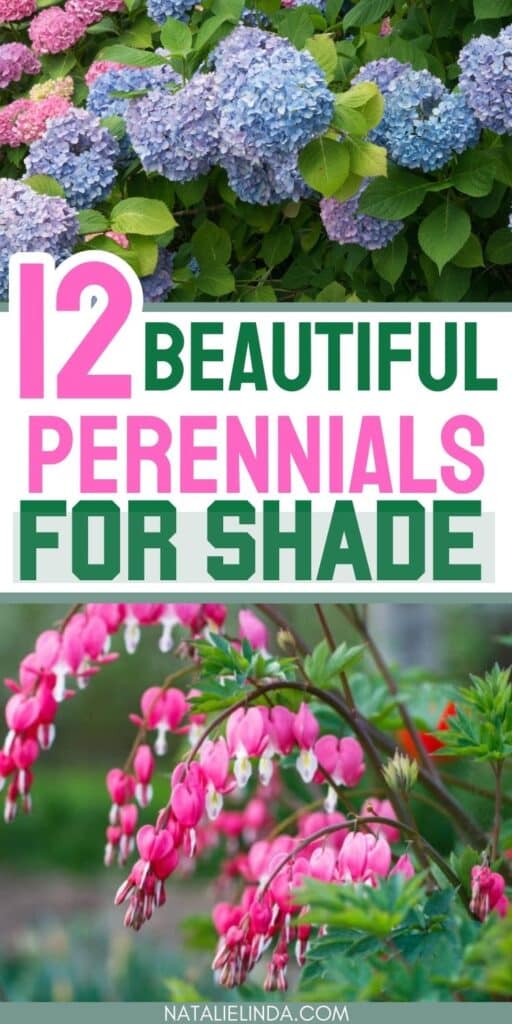
INTERESTED IN LEARNING MORE ABOUT PERENNIALS?
Check out the posts below to get garden ideas for your perennial landscape design!
18 Low-maintenance Perennials for Your Garden
DIY Side Yard Ideas for Transforming a Small Yard
15 Full Sun Perennials
10 Colorful Perennials that Bloom in the Fall
Best Tips on Caring for Lavender Plants
How to Plant and Care for Peonies
How to Grow a Lilac Bush for Beautiful Spring Blooms
How to Grow Echinacea Coneflowers
Thank you for suggestions..I have a very shady back yard
Good luck with your garden, Basha! Glad this post helped.